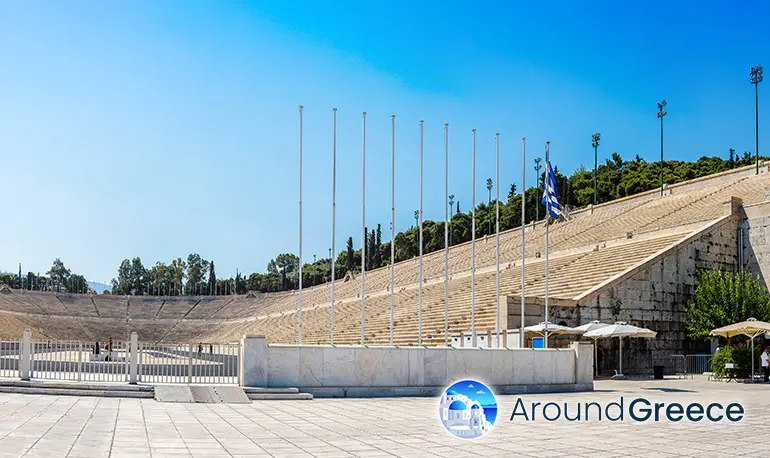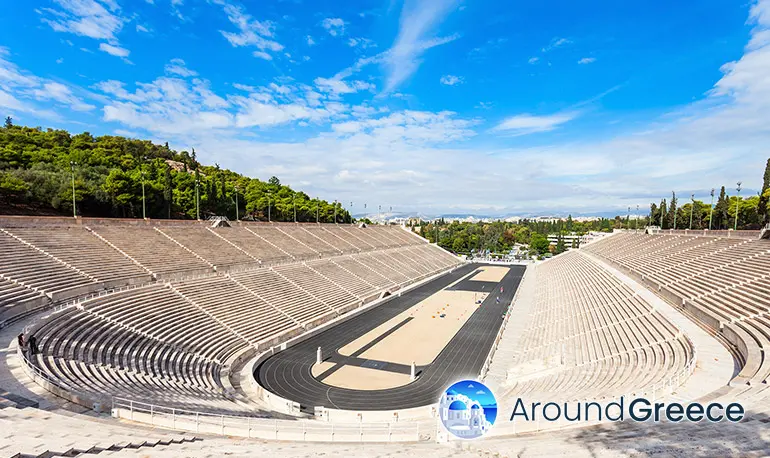Kallimarmaro - Home of the 1st Modern Olympics
The first thing to mention about the Olympic Stadium in the centre of Athens is that it is not to be confused with the New Athens Olympic Stadium where the 2004 Game were held, and which are located in the northern district suburb of Marousi.

Situated behind the National Gardens is the Panathenaic Stadium, the white marble arena that was used for the first modern Olympic Games in Athens in 1896. Though this stadium is relatively new in terms of other sites and monuments to be found in Athens, it has a long and historic background, and is definitely an attraction that all visitors to Athens should try and visit.
The original wooden stadium that was built on this site was constructed in 330 B.C., and was intended for use for the Panathenian Games, hence the name that it carries today of the Panathenaic Stadium.
During the Roman rule of Athens, the stadium was used for bloodsports, such as animal fights and gladiatorial duels. Up until this period in time, such sports were unknown in Greece, in Rome they were extremely popular.
In 140 A.D., under the funding of the Roman General “Herodes Atticus”, the stadium was rebuilt, with the original wooden design being abandoned. Marble from Mount Penteli was used, and the 60,000 capacity stadium was completed for the Panathenian Games in the same year. The stadium consisted of 47 rows and was designed so that it could be filled and vacated very quickly, with the use of the 29 flights of steps heading up amongst the many rows.

During the middle ages, the stadium suffered the same fate as many other of the ancient buildings and temples around the city, in that the materials used for its construction had been plundered, usually as a method of obtaining cheap cost marble.
It wasn't until the 19th Century that reconstruction of the stadium began. This time, the funding was provided by the Greek Georgios Averoff, who was an Alexandria-based businessman.
Though the first modern Olympic Games took place in 1896, the stadium itself, was not actually fully completed until 1906. The 1896 Olympics took place in a partially completed stadium, though this did nothing to cause any problem to the Games themselves.

The prestine whiteness and symetry of the stadium at the time of its completion must have resembled the stadium as it was when first opened during the Roman times. The endless rows of marble seating are wonderful photo opportunities, especially if you head to the top row and catch a glimpse of the Acropolis and Parthenon looking on in the background.
Over the years, with the modernisation of athletics, the stadium has become unsuitable for modern athletics and sports, mainly due to the curves of the track and sport area being too tight. It is still used though as the finishing point for the Athens Marathon, as well as for public gatherings, such as the homecoming celebrations for the Greek Olympic Team after the 2000 Sydney Games, and the celebrations following the National Greek football team, after their victory at the 2004 European Football Championships.
In 2021 it was home to a unique fashion show that was produced by Dior, with models walking along the tracks. The show was presented for the Dior 2022 Cruise Collection, which was inspired by ancient Greek art and culture.
Map of the Panathenaic Stadium
Below you will find a map which shows the location of the Panathenaic Stadium in Athens. Click on the map image below to load the Google map.
Visitor Information
Opening Hours:
March - October: 08:00 – 19:00
November - February: 08:00 – 17:00
Entrance Fee / Prices:
5 Euros | Reduced 2.50 Euros
Location:
The Panathinaiko Stadium is located in the Pangrati district of Athens, and is only a short distance from the National Gardens.
Top Sights in Athens
- Ancient Agora
- Areopagus (Hill of Ares)
- Athenian Trilogy
- Filopappou Hill
- First Cemetery of Athens
- Hadrian's Arch
- Hadrian's Library
- Hill of the Nymphs
- Kerameikos Cemetery
- Lycabettus Hill
- Lysicrates Monument
- National Gardens
- Panathenaic Stadium
- Pnyx
- Roman Agora
- Syntagma Square
- Temple of Olympian Zeus
- Tower of the Winds
- Zappeion
